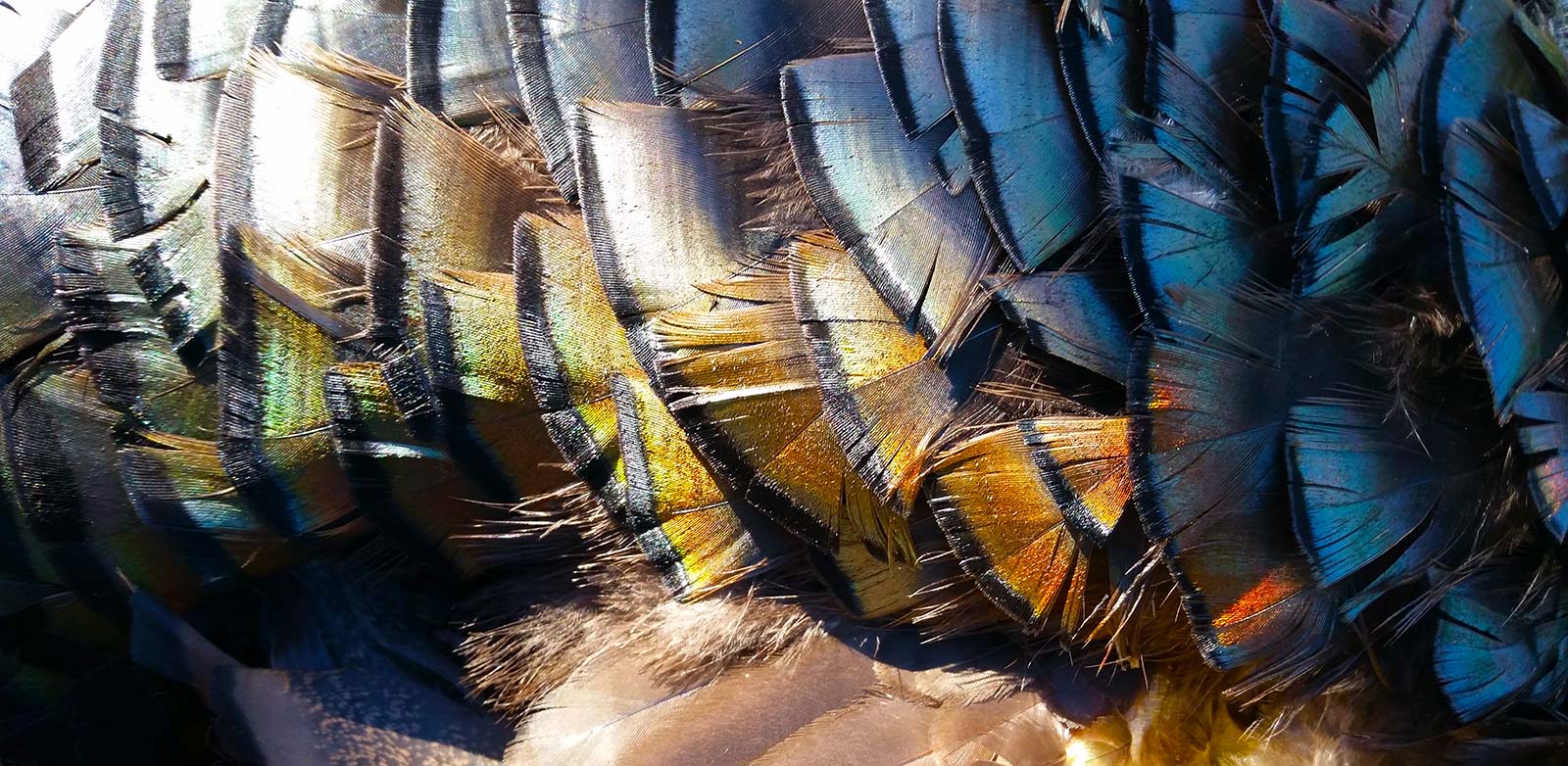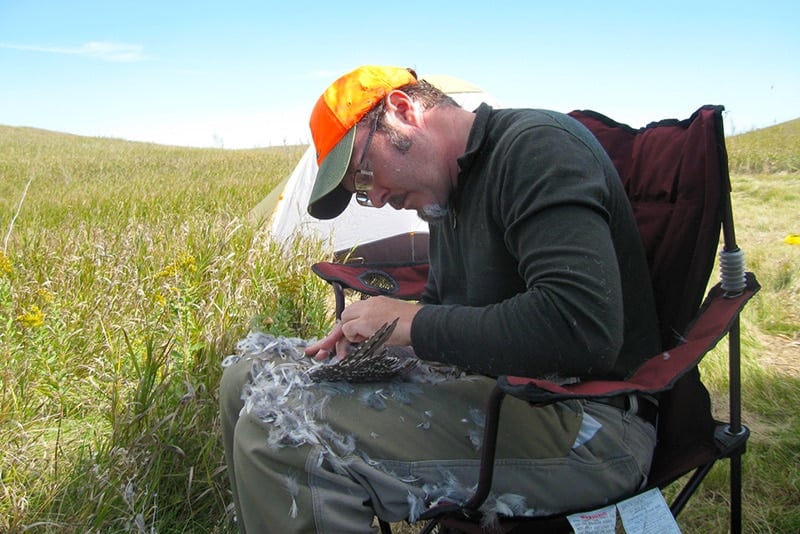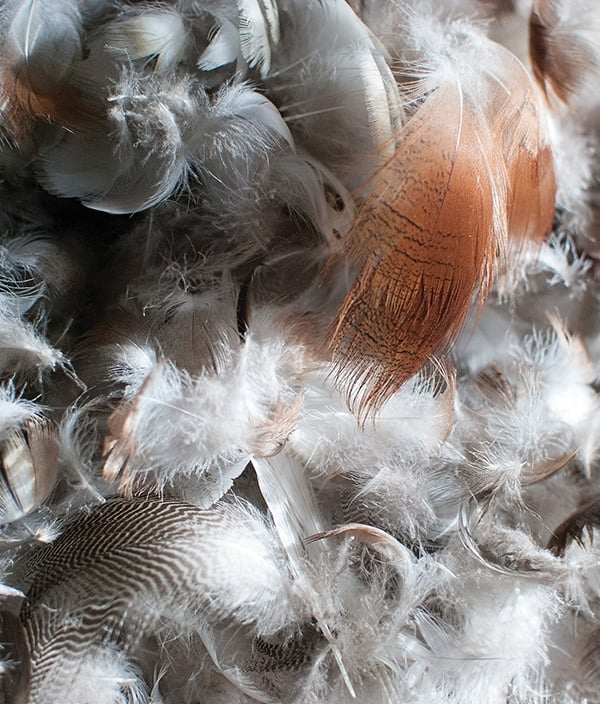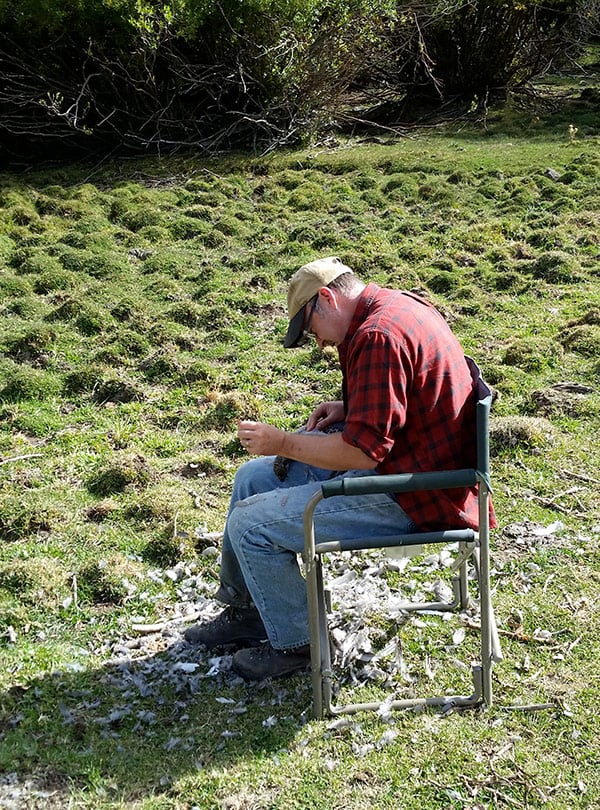As an Amazon Associate I earn from qualifying purchases.

I’ve picked an inordinate number of grouse this fall. Sage grouse, sharpies, blue grouse, prairie chickens. Throw in some mountain quail and a bucket of doves, plus one pigeon, and you can say I’ve been quite the mother plucker this year. And duck season hasn’t even started yet.
I am here to make the case for plucking birds.
Plucking a bird is an act very much like unearthing an archaeological treasure. It can be a painstaking business, frustrating, messy and yet, when you are done, deeply rewarding. It is an act of love, in an odd way. You are working hard to bring out the best in your birds.
For me it is a calming process, a task I can zen out on, focusing only on the next feather. Plucking occupies the same mindspace for me as making pasta: Mindless, yet highly focused.
Hunters out there, I know, I know. I can feel your skepticism through the interwebz. And I can almost hear you say it… “You pluck all your birds?!” For the most part, yeah, I do. If I had a dollar for every time I heard someone say that, I’d have enough money to buy a new shotgun.

Those of you who raise chickens or turkeys or ducks know that you must pluck your birds for the market because we, as consumers, simply would not buy a skinned chicken or turkey. (Yes, I know there is a large market for skinless, boneless chicken breasts. But those are mostly eaten by people who hate food.) And can you imagine someone selling duck breasts without all that yummy fat and skin? Heresy.
Hunters, you owe it to yourself to pluck your birds. I don’t want to sound scolding or holier-than-thou, but eating a beautiful plucked pheasant or quail or duck is one of life’s great joys at the table, and it really is worth the effort.
What’s the big deal? Almost all of a bird’s distinctiveness resides in the skin and fat. I’ve written extensively on the relationship between fat and flavor elsewhere, but suffice to say that if you skin your birds you will have an awfully hard time telling a bite of coot breast apart from a bite of canvasback breast. Honestly. And trust me, I’ve done blind tests.
I just did a test a couple weeks ago, where I served some friends slices of pintail, canvasback and mallard breasts — all with skin and fat. Everyone preferred the pintail, but the canvasback was a universal second. The mallard was, well, boring. None of this would be discernable without skin and fat, and you cannot get skin and fat on a bird without plucking.
But even I do not pluck every single bird I come home with. So, when to pluck and when not to? Here is what I do:
- If the bird has been terribly shot up or mauled by your dog, or. God forbid, someone else’s, skin it.
- Wingshot birds will often have pristine breasts, so always pluck them.
- Pluck “quality” ducks and geese — mallards, black ducks, pintail, canvasbacks, teal, specklebelly geese and, in certain cases, wigeon, gadwall, redheads, bluebills and Canada geese.
- For the most part, skin snow geese, which have weird blue skin and almost no fat; there are exceptions to this, as I’ve written about here. Skin all sea ducks or divers shot near salt water, again, with rare exceptions. They will almost always taste fishy. If you eat coots, skin them, too.
- The rarer the quarry, the most important it is to pluck it. You might not get too many ruffed grouse or sandhill cranes or woodcock, so be sure to enjoy everything that bird has to offer by plucking it.
How to Start?
To dry pluck, all you need is patience and a good set of kitchen shears. The shears are to clip the wingtips (even I don’t bother plucking the last section of a bird’s wings) and to chop off the bird’s head.
To wet pluck, you will need slightly less patience, a good set of kitchen shears, and a really big canning pot. If you are plucking waterfowl, you will also need several pounds of wax (more on that in a bit). I use Parowax Household wax, which you can usually find in canning sections of most supermarkets.
Now that you have the equipment, here’s how I pluck various game birds.
For starters, always pluck before gutting the birds. (You’d be surprised how often I get that question.)
As for various bird species, I’ve already written a tutorial on how to pluck a pheasant. These instructions work for all gallinaceous birds: pheasants, partridges, turkeys, quail, grouse of all varieties — and yes, chickens. Know that ruffed grouse, sharp-tailed grouse and quail skin is unusually tender, and that turkey skin is pretty damn tough. Other than that, they’re all pretty much the same.
Doves and pigeons are the easiest birds to pluck. Once you get the hang of it, you can pluck a dove in about 2-3 minutes. Always dry pluck doves and pigeons. (Here’s our video on plucking doves.)
Woodcock should also be dry plucked. Snipe are persnickety to pluck (say that five times fast!), and I often wax them like ducks, but woodcock are nearly as easy as doves and pigeons.

Waterfowl are a different case. Ducks and geese require their own techniques for plucking.
On the plus side, their skin is pretty tough, so you are less likely to tear it compared to plucking a pheasant or quail. On the down side, is, well, down. Waterfowl have a layer of gossamer down under their regular feathers that keeps them warm and waterproof. It is not easy to get off by hand.
You can dry-pluck any waterfowl, but it will take longer than it would for a comparably sized upland bird, and you must deal with the fact that the wing feathers are extremely difficult to pull out. Think about it: Ducks fly thousands of miles in their migrations, while pheasants rarely fly at all, and when they do they fly only short distances. (Here is my video on dry plucking a duck.)
Wet-plucking is the way to go, only with a twist. I pluck all my ducks with the aid of canning wax, or paraffin. We go through many blocks of it each year, so stock up. The trick is to get a giant pot of water steaming – not boiling – melt wax in it, and dunk your birds. Toss the waxed birds in another basin of ice cold water to set the wax, let them cool a bit and pluck away. The wax grabs the down and upper feathers, leaving you with a nice clean plucked duck.
While your pot of water heats up, examine your ducks and geese. Chop off badly damaged legs or wings. Now rough-pluck your birds. Pull out the tail feathers, the big wing feathers (you might need to go one by one with geese), and some of the regular feathers on the body of the bird. Be careful when you do this, and anchor the skin of the duck with one hand while you pluck with the other.
Put the wax in the water. How much? Our paraffin comes four blocks to a box, and we find that a goose needs a full block. Big ducks need half, and on smaller ducks you can get away with 2 to 3 to a block.

Once the birds are rough-plucked and the wax is melted, grab the bird by the head and dunk it up to its neck in the water. Swirl it around a bit on the surface, too, and make sure you get it well coated. Let it drip a little over the pot, then put the waxed bird into a basin of cold water; we use our slop sink in the garage. Let the bird chill for a few minutes, then put it somewhere to drain.
Wear an apron or something when plucking, because it is a messy, wet business. Start with the wings, as they are the hardest part. You might need to break the wax seal on parts of the bird to peel off the wax. Again, anchor the skin with one hand while you peel with the other. Many times you are actually keeping the wax on one place while gently peeling the skin away from it – this is especially important when working around shotgun pellet holes.
After I do the wings, I go to the tail, then the back, then the legs. Finally, I do the neck and breast. The neck skin is loose, and this is the most likely place for a tear. The breast is the most prized part of the bird, so you will want your full attention here. It’s like opening a present: The breast gives you the best look at whether you have a fat bird or a skinny one. (Here’s a video of our wet-plucking process.)
So that’s it. That’s what I know about plucking game birds. But there are other ways out there.





Please explain your method of leaving a bird refrigerated for a few days before plucking and gutting.
Charley: What’s to explain? Leave them in the fridge and then pluck them. Doing this makes the plucking go easier.
I keep all my feathers and have used the down to make an outstanding down blanket and have used the feathers to make two giant dog beds. I dry pluck ducks and geese but only the front side for the breasts, I don’t keep the skin on the legs. Its a bit messy with all the feathers but canada goose down is high quality and will last a lifetime in whatever purpose you use it.
In the spirit of using as much as possible of an animal, would you say one could keep the feathers and use it to stuff pillows? if one is careful it might be possible to collect down for some home made insulant… it might be impossible or impractical, but I am tempted to try!
Federico: Yes, that was done a lot in the past. I think you need to sterilize them somehow to kill any little mites that might be in the feathers.
How soon do you need to pluck and dress a dove? I tried plucking on my trip to Yuma this weekend. We put the birds on ice while we drove back to the hotel, used the hotel cleaning station to pluck and gut, back on ice for the drive home to Phoenix, and then plucked the last wing and rinsed them. Timing was probably 2 hrs in the shade, 30 min on ice, plucked and gutted, 3 hours on ice, final plucking and rinse, so ~5 hrs from start to finish. Would you recommend anything different here? What part matters the most in this process?
Eric: Sounds about right. I’ve done the same thing.
Hi Hank: We are lucky enough to have some good woodcock and snipes hunting spot around here (Quebec, Canada). I’m wondering if you have a tip for me on plucking woodcock. It seems there is always those small pin feathers that remains under the skin. Anyway to take that off quickly and not taking tweezers? Hey I love your blog btw and read it every week and tried a lot of your recipes too.
Nevermind, I now read more carefully and see turkeys are lumped in with pheasants. Thanks for all the great info you put out.
Can you tell me what temperature the hot water should hold?
Kristine: About 140 degrees Fahrenheit.
Everyone needs a good “plucking post”, much like falcons and “true” hawks (Sharp-shinned, Cooper’s, and Goshawks). I pluck nearly all of my birds with very few exceptions. That photo could very well be me in our back yard. A chair, a bird, and over time a growing mound of feathers (and a beer or two to help me cope with what I’ve just done). Plucking a bird gives me time to sit and reflect on the day and affords me one of the the most beautiful things besides a living bird; a plucked bird… and a buzz!
Tim: I’ve got bags and bags full of duck and goose down. Fetching to make something some day; something that will be very special (and warm) to me.
I don’t usually hunt but a couple years ago I got a Canada goose. I looked up all the info I could find on the net about defeathering and dressing it. I was shocked by the number of videos where all they did was cut the breast meat out and waste the whole rest of the bird because “plucking was just too time consuming.” Well, I sat down and plucked my bird and was also surprised by how quickly it went. What were those people complaining about? Do they never work with their hands? IMO, some people just shouldn’t hunt. Not only did I cook and eat the whole bird, I also saved all the down and feathers I could. I also sew some of my own clothes and have used some of that down to add a bit of insulation where I could. BTW, some of those feathers in your pictures would make nice fly tying material.
What are your thoughts on using plucking machines for larger game birds? We use them for our chickens but I think it would work on a duck or goose too assuming it’ll take the down away.
Grayson: They work, but require skill to master. I’d practice on “off” ducks until you get good at it.
Can the paraffin wax be used also for defeathering chickens?
Rel: I’ve never used it. The paraffin is best to remove down, and chickens don’t have any.
Could I use my turkey fryer for this or is that not a good idea?
Joe: Not a good idea. You want a dedicated pot, because it gets a little gnarly over time.
For the sake of time management, is it ok to do the “primary” plucking on a few birds one day, and then take care of the waxing a day or two later?
Chris: I’ve done that. Just keep them cold.
I tried a plucker like the one you described Andrew and it didn’t do as good a job as I hoped. I still had to tediously pluck by hand. In my opinions I should have put the money spent renting the plucker on wax.
Have you ever tried the “Fowl Plucker” (https://thefowlplucker.com/) or similar devices? Basically a motor driven head with a bunch of soft rubber fingers that dry pluck a bird. I’m curious as to your thoughts on using something like that to pluck as it is apparently so fast. Expensive for the name brand. Saw some DIY versions that would be cheap enough to try out.
Hello Hank,
I’ve started plucking birds this year after a lifetime of skinning. I now feel somewhat guilty for all the grouse I’ve breasted out by stepping on the wings and pulling the feet. Alas, I’ve had some trouble while plucking with the little base of the feathers (looks like a PIT tag, if that helps) being left behind in the skin, both after dry plucking and attempts at wet plucking. Do you have any advice that will help me avoid picking out these little feather bases one at a time?
Thanks and keep up the great work
Kirby: Sadly, you just need to pick em out by hand. Price of admission, I suppose.
My questions is a short one, how do you clean up the mess after using wax, is it hard to get it out of your pot etc. Is there any pointers to follow?
We do it in the garage, with a concrete floor. We scrape it down once a season. You need to sweep up the large feathers, but you can vacuum the small ones.
Hey Dawn dish soap started with a commercial back in the 60’s. they showed a mallard swimming in a tank of water, then added Dawn and the mallard started to sink.
An announcer stated that Dawn was so good at cutting grease that even a duck can’t swim in it. ( a duck preens his feather’s with oil from his oil gland and this is what keeps him water proof and dry and floating)
The soap washes the oil away and allows the hot water to get through to the skin and scald, thus helping to loosen the feathers.
This is also why Dawn has donated lots of it to clean unfortunate wild life after major oil spills
I am new to this, but I read that dry plucking is much easier, and the ducks will taste better if you let them air dry in a spot that’s between 35-38 degrees for 4-7 days. I’m going to test this theory when we butcher our second batch of ducks. We already butchered the first 2 and they are hanging in a meat fridge to air dry, the next batch we will try wet plucking maybe. I want to make the dry plucking go as easy as possible so I can save the down feathers!
Every time iv plucked ducks iv dry plucked them its work for sure but not to bad , I was curious about the pin feathers I usually just pull out with tweezers .but sometimes there are a couple that break off at the base besides trimming it out I did not know what to do.
Also has anyone used the plucker machines with the rubber fingers herd they work well